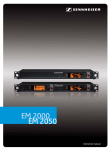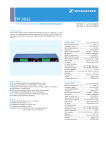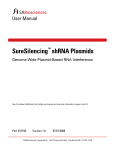Download Sennheiser EK3253 Specifications
Transcript
SR 3254 SR 3256 Instructions for use 4 SR 3254 SR 3256 Thank you for choosing Sennheiser! We have designed this product to give you reliable operation over many years. Over sixty years of accumulated expertise in the design and manufacture of high-quality electro-acoustic equipment have made Sennheiser a world-leading company in this field. Please take a few moments to read these instructions carefully, as we want you to enjoy your new Sennheiser products quickly and to the fullest. Contents Safety instructions ............................................................................ 6 SR 3254/SR 3256 transmitters ...................................................... 8 Delivery includes ................................................................................ 9 Overview of operating controls ....................................................10 Indications and displays .........................................................................11 Preparing the transmitter for use ................................................12 Using the transmitter as a stand-alone unit ......................................12 Rack-mounting several transmitters ...................................................13 Connecting the transmitter to the mains ............................................15 Using transmitters in a multi-channel system ...................................16 Using the transmitter .....................................................................18 Switching the transmitter on/off .........................................................18 The operating menu of the transmitter ......................................20 Overview of the operating menu ..........................................................21 Selecting the frequencies to be stored in the channel bank “U” – TUNE .......................................................................................22 Selecting a channel from the channel bank “U” or “F” – CHANNEL ....................................................................23 Switching between mono and stereo operation – MONO/STEREO .....................................................................23 Care and maintenance ....................................................................24 Cleaning the transmitter ........................................................................24 Replacing the fuse ....................................................................................24 If problems occur ... .........................................................................26 Error checklist ....................................................................26 Additional information ...................................................................27 Specifications ...................................................................................28 Connector assignment ............................................................................29 Accessories .......................................................................................30 Safety instructions y Please read these instructions carefully and completely before using the transmitter. y Make these instructions easily accessible to all users at all times. Always include these instructions when passing the transmitter on to third parties. y Never open the transmitter, otherwise you can receive an electric shock. If units are opened by customers in breach of this instruction, the warranty becomes null and void. y Keep the transmitter away from direct sunlight, central heating radiators, electric heaters and similar sources of heat. Ensure sufficient ventilation, especially when it is mounted into a 19" rack. y Water entering the housing of the transmitter can cause a short-circuit and damage the electronics. Protect the transmitter from damp and wet. y Do not place any objects containing liquids on the top of the transmitter. y Use the transmitter in dry rooms only. Never expose it to water (e.g. never place it in a position where it could be subjected to water splashes). y Only use a slightly damp cloth to clean the transmitter. Attention! High volume! This is a professional transmission system. Commercial use is subject to the safety-at-work regulations. Sennheiser, as the manufacturer, is therefore obliged to expressly point out possible health risks arising from use. This system is capable of producing sound pressure exceeding 85 dB(A). 85 dB(A) is the sound pressure corresponding to the maximum permissible volume which is by law (in some countries) allowed to affect your hearing for the duration of a working day. It is used as a basis according to the specifications of industrial medicine. Higher volumes or longer durations can damage your hearing. At higher volumes, the duration must be shortened in order to prevent damage. The following are sure 6 signs that you have been subjected to excessive noise for too long a time: y You can hear ringing or whistling sounds in your ears. y You have the impression (even for a short time only) that you can no longer hear high notes. Intended use of the transmitter Intended use includes y having read these instructions especially the chapter “Safety instructions”. y using the transmitter within the operating conditions as described in these instructions. Improper use Improper use is when you use the transmitter other than described in these instructions or when you use the transmitter under operating conditions different from those described in these instructions. 7 SR 3254/SR 3256 transmitters With the wireless in-ear monitoring system, consisting of the SR 3254 or SR 3256 stereo transmitter and the EK 3253 bodypack receiver, musicians, video and sound amateurs, reporters/broadcasters, etc. can directly monitor the received sound signals without troublesome cables or monitor speakers being required. In addition, the system can also be used for any application where talkback signals are to be transmitted. The system has superb audio quality with an increased signalto-noise ratio and dynamic range due to the inclusion of Sennheiser’s HDX noise reduction system. The SR 3254 is a single stereo transmitter in a 19" 1 U housing. 4 SR 3254 The SR 3256 consists of two complete stereo transmitters in a 19" 1 U housing. SR 3256 The stereo transmitters have the following features: y Easy to use y Stereo/mono selector switch y Switching bandwidth of 36 MHZ per transmitter y Transmission frequencies tunable in steps of 5 kHz y HDX noise reduction system with more than 90 dB signal-tonoise ratio y LC display for frequency, RF output power and deviation y Rugged 19" housing with built-in mains unit; supplied with rack-mounting kit y Suitable for multi-channel applications y RF output power of up to 100 mW 8 The channel bank system The SR 3254/SR 3256 transmitter is available in five UHF frequency ranges: Range A: Range B: Range C: Range D: Range E: 518 to 554 MHz 626 to 662 MHz 740 to 776 MHz 786 to 822 MHz 830 to 866 MHz The transmitter has two channel banks with up to 16 switchable channels each. The channels of the channel bank “F“ (fixed bank) have been factory-preset to customer-specific transmission frequencies. These frequencies cannot be changed. The channel bank “U” (user bank) allows you to freely select and store frequencies. Recommended receiver y EK 3253 Delivery includes y 1 SR 3254 transmitter or 1 SR 3256 twin transmitter y 1 rack-mounting kit y 1 mains cable y 1 telescopic antenna (with the SR 3254) or 2 telescopic antennas (with the SR 3256) y Instructions for use 9 Overview of operating controls Headphone output, ¼” (6.3 mm) jack socket Fuse holder and mains voltage selection (230 or 115 V) Headphone volume control 2-pin IEC mains connector LCD bargraph for deviation of the left channel (DEV L), with overmodulation display (“PEAK”) Cable grip for mains cable LCD bargraph for deviation of the right channel and “MONO” (DEV R), with overmodulation display (“PEAK”) Audio input, left (AF IN (L)) LCD bargraph for RF output power (RF) Alphanumeric LC display SET button Programming interface, 15-pin sub-D socket Audio input, right (AF IN (R) + MONO) Type plate Antenna output 왖 button (UP) 왔 button (DOWN) POWER button Note: Connections and operating controls marked with a star () in the above illustration are those for the second transmitter of the SR 3256 twin transmitter. 10 Indications and displays Alphanumeric display “FREQUENCY MHZ” display “CHANNEL” display LC dot CHANNEL LC dot TUNE LC dot MONO/STEREO LC dot STEREO (transmitter is set to stereo operation) LC dot MONO (transmitter is set to mono operation) MUTE display (transmitter is muted) 6-step bargraph for RF output power 11-step deviation bargraph (two separate bargraphs for the left and right channel) Deviation display The two bargraphs indicate the deviation of the audio signal of the left and right channel. When the transmitter’s audio input level is excessively high, “PEAK” lights up. Display of the RF output power The bargraph indicates the RF output power. During normal operation, an RF output power of 100 % is indicated. 11 Preparing the transmitter for use Using the transmitter as a stand-alone unit Mounting the transmitter feet To ensure that the transmitter cannot slip on the surface on which it is placed, four self-adhesive soft rubber feet are supplied. 왘 Ensure that the base of the transmitter is clean and free from grease before mounting the rubber feet. 왘 Fix the rubber feet to the base of the transmitter by peeling of the safety paper and fitting them as shown in the diagram on the left. Attention! Some furniture surfaces have been treated with varnish, polish or synthetics which might cause stains when they come into contact with other synthetics. Despite a thorough testing of the synthetics used by us, we cannot rule out the possibility of staining. Connecting the telescopic antenna When using the transmitter as a stand-alone unit, connect the supplied telescopic antenna !. The telescopic antenna can be mounted quickly and easily and is suitable for all applications where – good transmission conditions provided – a wireless transmission system is to be used without a large amount of installation work. 왘 Connect the telescopic antenna to the BNC socket at the rear of the transmitter. 왘 Pull the end cap to extend the telescopic antenna. Optimum transmission and reception conditions can be obtained by using remote antennas (see “Mounting and connecting remote antennas” on page 17). 12 Rack-mounting several transmitters You can use the supplied rack mount “ears” to mount the transmitter into a 19" rack (1 U). If you wish to mount the antennas to the front of the rack, use the GA 3030-AM antenna mount (see “Accessories” on page 30). Setting up the transmitters The SR 3254 and SR 3256 transmitters heat up during operation. y Ventilation in fixed installations Ensure sufficient ventilation, especially when the transmitters are mounted into a desk or chassis. Provide for a duct of sufficient size to ensure a free air flow between the transmitters. y Sufficient ventilation in a rack When operating several transmitters in a rack, ensure sufficient ventilation or cooling. We recommend not stacking more than two transmitter directly one above the other, and then providing for a duct of sufficient size to ensure a free air flow between the transmitters. Rack-mounting the transmitter without mounting the antennas to the front of the rack 왘 Hook the two rack mount “ears” " to the rear of the transmitter. 왘 Secure the rack mount “ears” to the left and right of the transmitter using four recessed head screws respectively. 왘 Slide the transmitter into the 19" rack. 왘 Secure the rack mount “ears” " to the rack. 13 Rack-mounting the transmitter and mounting the antennas to the front of the rack 왘 Mount the antenna holders to the handles of the transmitter as shown in the diagram on the left. 왘 Hook the two rack mount “ears” " to the rear of the transmitter. 왘 Pull the cables of the antenna holders in the rack mount “ears”. through the holes 왘 Secure the rack mount “ears” to the left and right of the transmitter using four recessed head screws respectively. 왘 Connect the cables of the antenna holders to the antenna sockets at the rear of the transmitter. 왘 Slide the transmitter into the 19" rack. 왘 Connect the telescopic antennas to the BNC sockets of the antenna holders . 14 Connecting the transmitter to the mains The transmitter can be connected to 230 V or 115 V AC. Before you plug the mains connector into the wall socket, please first check that the transmitter is set to the correct mains voltage! The set voltage is shown at the top of the fuse holder . Selecting the mains voltage WARNING! Electric shock hazard! In case of improper handling, you may come into contact with electrically conducting parts and receive an electric shock when removing the fuse holder. 왘 Before removing the fuse holder, pull out the mains connector from the wall socket. To select the mains voltage, proceed as follows: 왘 Disconnect the transmitter completely from the mains by pulling out the mains connector from the wall socket. 왘 Use a screwdriver to loosen the fuse holder . 왘 Remove the fuse holder with the inserted fuse. 왘 Turn the fuse holder by 180° and reinsert it. The set voltage is shown at the top of the fuse holder. 15 Connecting the mains cable 왘 Insert the supplied mains cable into the socket on the transmitter and pass the cable through the cable grip. Note A cable grip is particularly important when the transmitter is permanently rack-mounted. Inside the rack there are often a large number of cables – a cable grip prevents the cables from pulling each other out. Using transmitters in a multi-channel system You can combine several transmitters to make a multi-channel system. To do so, you require an antenna combiner (e.g. the AC 3000, see “Accessories” on page 30) which allows you to combine the signals of up to four twin receivers onto a single antenna (see diagram below). For detailed information on setting up a multi-channel system and on connecting the transmitters, please refer to the operating manual of the antenna combiner. ANT RF OUTPUT 8:1 16 Mounting and connecting remote antennas Use a remote antenna when the transmitter position is not the best antenna position for optimum transmission. You can choose between two antennas (see “Accessories” on page 30): y A 2003 UHF passive directional antenna y A 1031 passive omni-directional antenna A 2003 A 1031 Use a low-attenuation 50-Ω cable to connect the antenna to the transmitter. Ready-made antenna cables from Sennheiser are available as accessories with length of 5 m and 10 m. If possible, use a short antenna cable and as little connections as possible, since long cables and many connectors lead to an attenuation of the antenna signal. Position antennas in the same room in which the transmission takes place! Maintain a minimum distance of 1 m from metal objects (including reinforced concrete walls)! Connecting the mixing console Connect the mixing console to the XLR-3 sockets AF IN (L) and AF IN (R) + MONO . Note Any unit that is only suitable for mono operation must be connected to the XLR-3 socket AF IN (R) + MONO . In this case, set the transmitter to mono operation (see “Switching between mono and stereo operation” on page 23). 17 Using the transmitter Switching the transmitter on/off 왘 Press the POWER button to switch the transmitter on or off. After switch-on, the LC display is backlit and the last transmission frequency set is displayed. Until the PLL has locked on the desired transmission frequency, the transmitter is muted. “MUTE” appears on the display and the LCD bargraph for RF output power (RF) indicates 0 %. Note The POWER button works in the secondary circuit of the integrated mains transformer, and thus only switches the low voltage side. For larger installations with several transmitters, a complete mains disconnection can best be achieved by a central ON/OFF switch. Connecting the headphones/monitoring the audio signal Attention! High volume! Even short exposure to high volume levels can damage your hearing! Set the volume for the connected headphones to the minimum before putting the headphones on. Do not listen at higher volume levels than with loudspeakers. 왘 Connect headphones with a ¼“ (6.35 mm) stereo jack plug to the headphone output to monitor the stereo audio signal present at the audio inputs AF IN (L) and AF IN (R) + MONO. Note Even during mono operation, the left and right channel are reproduced separately via the headphones. 18 왘 First, set the volume control # to the lowest volume by turning it to the left as far as possible. Then gradually turn up the volume. 19 The operating menu of the transmitter Via the operating menu, you can quickly and easily change the following settings: Menu Function of the menu TUNE Setting a transmission frequency for the channel bank “U” (user bank) CHANNEL Selecting a channel from the channel bank “U” or “F” MONO/STEREO Switching between mono and stereo operation The buttons In the operating menu, all settings can be made using the 왖 , 왔 and SET buttons: Buttons 왖/왔 Mode Function of the button Display mode Selects a menu. Setting mode y Briefly pressing the button: The display jumps either forwards or backwards to the next setting. y Holding down the button (“TUNE” and ”CHANNEL” menu): The display cycles continuously (“fast search” function). The “fast search” function allows you to get fast and easily to your desired setting. SET Display mode Changes to the setting mode of the selected menu. Setting mode y Stores the setting and returns to the display mode. y In the “TUNE” menu: Confirms the selection of the channel for which you want to set the frequency. Canceling an entry When in the setting mode of a menu, you can cancel your entry at any time by pressing the 왖 and 왔 buttons simultaneously. The cancellation is briefly confirmed on the display with “ESc.”. The previous setting is kept and the transmitter returns to the display mode. 20 Overview of the operating menu Display mode Setting mode Press SET for 1 sec. SET Current channel : U 1... U 16, F 1... F16 SET: Selects the channel SET : Transmission frequency in steps of 5 kHz Current frequency SET SET Current channel or current frequency Changing the channel : U 1... U 16, F 1... F16 SET SET Switching between mono and stereo operation Current setting : Mono, Stereo SET 21 TUNE Selecting the frequencies to be stored in the channel bank “U” Via the “TUNE” menu, you can freely select the frequencies to be stored in the channel bank “U” (user bank). 왘 Press the 왖/왔 buttons to select the “TUNE” menu. The LC dot “TUNE” lights up. 왘 Press the SET button to get into the setting mode of the “TUNE” menu. The LC dot “TUNE” and the “FREQUENCY MHZ” display start flashing. Note When pressing the SET button for one second, you can use the 왖/왔 buttons to select a different channel for which you can then change the frequency. When you have selected the channel bank “F” and then select the “TUNE” menu, the transmitter automatically switches to channel 01 of the channel bank “U” and “U.01” appears on the display. Otherwise, the current channel of the channel bank “U” is displayed. 왘 Press the 왖/왔 buttons to select the desired transmission frequency. Transmission frequencies are tunable in 5-kHz steps within a switching bandwidth of 36 MHz max. 왘 Press the SET button to store your selection. “Sto.” briefly appears on the display. While the transmitter changes to the new frequency, it is muted. 22 CHANNEL Selecting a channel from the channel bank “U” or “F” 왘 Press the 왖/왔 buttons to select the “CHANNEL” menu. The LC dot “CHANNEL” and the “CHANNEL” display light up. 왘 Press the SET button to get into the setting mode. 왘 Press the 왖/왔 buttons to select the desired channel. 1 Sek. 왘 Press the SET button to store your selection. “Sto.” briefly appears on the display. MONO/STEREO Switching between mono and stereo operation 왘 Press the 왖/왔 buttons to select the “MONO/STEREO” menu. The LC dot “MONO/STEREO” lights up. 왘 Press the SET button to get into the setting mode. 왘 Press the 왖/왔 buttons to select the desired operating mode. 왘 Press the SET button to store your selection. “Sto.” briefly appears on the display. 23 Care and maintenance Cleaning the transmitter CAUTION! Water can damage the electronics of the transmitter! Water entering the housing of the transmitter can cause a short-circuit and damage the electronics. 왘 Only use a slightly damp cloth to clean the transmitter. 왘 Before cleaning, disconnect the transmitter from the mains. 왘 If necessary, you can clean the transmitter with a slightly damp cloth. Do not use any cleansing agents or solvents. Replacing the fuse WARNING! Electric shock hazard! In case of improper handling, you may come into contact with electrically conducting parts and receive an electric shock when removing the fuse holder. 왘 Before removing the fuse holder, pull out the mains connector from the wall socket. 왘 Disconnect the transmitter completely from the mains by pulling out the mains connector from the wall socket. 왘 Use a screwdriver to loosen the fuse holder . 왘 Remove the fuse holder with the inserted fuse. 왘 Replace the fuse by a new fuse with the same rating. 왘 Reinsert the fuse holder. Make sure to insert the fuse holder the correct way round. The set voltage is shown at the top of the fuse holder. 왘 Reconnect the transmitter to the mains and and switch it on again. 24 If the replacement fuse also blows, please contact your local Sennheiser agent or send the transmitter, with a precise description of the trouble, to a Sennheiser service partner in your area. You can find the address of your nearest service partner in the enclosed service card or on the Internet at “http://www.sennheiser.com/sennheiser/icm.nsf/root/ service_partner”. 25 If problems occur ... Error checklist Problem Possible cause Possible solution No operation indication No mains connection Check the connections of the mains connector Fuse is defective Replace the fuse Transmitter and receiver are not on the same channel Set transmitter and receiver to the same channel Transmitter is out of range Change the antenna position Transmitter is set to mono operation and the pilot tone evaluation of the receiver is activated Deactivate the pilot tone evaluation on the receiver Receiver’s squelch threshold is adjusted too high Reduce the squelch threshold on the receiver Transmitter sensitivity is adjusted too low or too high See “Connecting the mixing console” on page 17 No RF signal RF signal available, no audio signal Audio signal has a high level of background noise or is distorted If problems occur that are not listed in the above table or if the problems cannot be solved with the proposed solutions, please contact your local Sennheiser agent for assistance. 26 Additional information HDX noise reduction RF link Inherent noise of the RF link Transmitter Receiver Progress you can hear: The product family is equipped with HDX, the Sennheiser noise reduction system that reduces RF interference. It increases the signal-to-noise ratio in wireless audio transmission to more than 90 dB. HDX is a wideband compander system which compresses the audio signal in the transmitter in a 2:1 ratio (related to dB) to lift it above the inherent noise floor of the RF link. In the receiver the signal is expanded in an identical and opposite way in a 1:2 ratio to restore the original signal, at the same time reducing the RF noise to below the noise floor of the receiver. HDX has been specially developed for high quality radio microphone systems. Note: Only transmitters and receivers that are equipped with HDX can work correctly with each other. If non HDX equipment was mixed with HDX, the dynamic range would be drastically reduced and the transmission would sound blunt and flat. 27 Specifications RF characteristics Frequency ranges 518–554, 626–662, 740–776, 786–822, 830–866 MHz Transmission frequencies 1 channel bank with up to 16 factory-preset channels 1 channel bank with up to 16 freely selectable channels (frequencies tunable in steps of 5 kHz) Switching bandwidth 36 MHz Frequency stability ±10 ppm (-10° C to +55°C) Antenna output BNC socket, 50 Ω RF output power max. 100 mW AF characteristics Modulation FM stereo working on the pilot tone principle Noise reduction system Sennheiser HDX Nominal/peak deviation ±24 kHz / ±48 kHz MPX pilot tone (frequency/deviation) 19 kHz / ±5 kHz AF frequency response 40–15,000 Hz Headphone output ¼“ (6.35 mm) stereo jack socket, ≥ 200 mW/32 Ω Load impedance of headphone output ≥ 16 Ω AF input 2 x XLR-3, electronically balanced AF input voltage (at nom. deviation) +4 dBu at 1 kHz, internally adjustable Signal-to-noise ratio > 90 dB(A)rms (refers to overall link with EK 3253) THD (at 1 kHz and nominal deviation) < 0.9 % Note: The above data also apply to the second transmitter in the SR 3256. 28 Overall unit Power supply 115/230 V AC +10% / –15% Power consumption SR 3254 max. 13 W Power consumption SR 3256 max. 23 W Dimensions (without rack mount “ears”) 436 x 228 x 43 mm (19", 1 U) Weight SR 3254 approx. 3,300 g Weight SR 3256 approx. 4,000 g Type approval USA: FCC-Part 74.861 FCC ID: DMOSREK3K Canada: RSS-123 IC: 2099A-SREK3K EU: ETSI EN 300 454-1/-2 CE 0682! Connector assignment SR 3254/SR 3256 ¼“ (6.35 mm) stereo jack plug for headphone output XLR-3 connector (male) + 2 1 3 29 Accessories AC 3000-EU Active Antenna combiner Cat. no. 009424 AC 3000-UK Active Antenna combiner Cat. no. 009410 AC 3000-US Active Antenna combiner Cat. no. 094409 A 1031-U Passive omni-directional antenna Cat. no. 004645 GA 3030-AM Antenna mount Cat. no. 004368 A 2003 UHF Passive directional antenna Cat. no. 003658 GZL 1019 A5 BNC-BNC coaxial cable, length 5 m Cat. no. 002325 GZL 1019 A10 BNC-BNC coaxial cable, length 10 m Cat. no. 002326 GZV 1019A BNC coupler Cat. no. 002368 HD 25 Monitoring headphone Cat. no. 002976 EK 3253 A Monitoring receiver Cat. no. 500522 EK 3253 B Monitoring receiver Cat. no. 500523 EK 3253 C Monitoring receiver Cat. no. 500524 EK 3253 D Monitoring receiver Cat. no. 500525 EK 3253 E Monitoring receiver Cat. no. 500526 30 Warranty regulations The guarantee period for this Sennheiser product is 24 months from the date of purchase. Excluded are accessory items, rechargeable or disposable batteries that are delivered with the product; due to their characteristics these products have a shorter service life that is principally dependent on the individual frequency of use. The guarantee period starts from the date of original purchase. For this reason, we recommend that the sales receipt be retained as proof of purchase. Without this proof (which is checked by the responsible Sennheiser service partner) you will not be reimbursed for any repairs that are carried out. Depending on our choice, guarantee service comprises, free of charge, the removal of material and manufacturing defects through repair or replacement of either individual parts or the entire device. Inappropriate usage (e.g. operating faults, mechanical damages, incorrect operating voltage), wear and tear, force majeure and defects which were known at the time of purchase are excluded from guarantee claims. The guarantee is void if the product is manipulated by non-authorised persons or repair stations. In the case of a claim under the terms of this guarantee, send the device, including accessories and sales receipt, to the responsible service partner. To minimise the risk of transport damage, we recommend that the original packaging is used. Your legal rights against the seller, resulting from the contract of sale, are not affected by this guarantee. The guarantee can be claimed in all countries outside the U.S. provided that no national law limits our terms of guarantee. EC Declaration of Conformity This equipment is in compliance with the essential requirements and other relevant provisions of Directives 1999/5/EC, 89/336/EC or 73/ 23/EC. The declaration is available on the internet site at www.sennheiser.com. Before putting the device into operation, please observe the respective country-specific regulations! 31 Sennheiser electronic GmbH & Co. KG 30900 Wedemark, Germany Phone +49 (5130) 600 0 Fax +49 (5130) 600 300 www.sennheiser.com Printed in Germany Publ. 08/05 513631 / A01









































